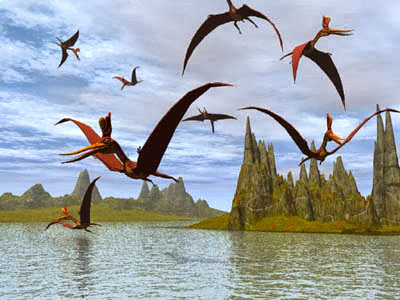The Evolution of Feathered Dinosaurs into Birds
As little as 50 years ago, the idea that birds descended from dinosaurs seemed completely ridiculous--after all, birds are small, light, fluttery creatures, while dinosaurs were huge, plodding, and distinctly unaerodynamic. But as the evidence--small dinosaurs possessing feathers, beaks, and other birdlike characteristics--began to mount, the connection between dinosaurs and birds became apparent to scientists and the general public. Today, it's the rare paleontologist who disputes the descent of birds from dinosaurs, though there are some who try.
This doesn’t mean, though, that all the technical aspects of the dinosaur/bird transition have been settled once and for all. Researchers still disagree about which dinosaurs were most closely related to modern birds, whether terrestrial dinosaurs sported aerodynamic or strictly ornamental feathers, and--perhaps most contentiously of all--how these reptilian proto-birds managed to achieve the huge evolutionary leap into powered flight.
Theory #1: Feathered Dinosaurs Took a Running Leap
Extrapolating backward from the behavior of modern birds, like ostriches, it's reasonable to infer that the small- to medium-sized, two-legged theropods of the Cretaceous period (notably the ornithomimids, or "bird mimics," but other feathered theropods as well, including raptors and possibly even small tyrannosaurs) could attain top running speeds of 30 or 40 miles per hour. As these theropods ran (either chasing down prey or trying to outrun bigger carnivores), their coat of insulating feathers gave them a slight aerodynamic "bounce," helping them land their next meal or live another day. Since well-fed dinosaurs, or those that avoided being eaten, produced more offspring, the evolutionary trend would be toward larger feathers, which provided more "lift."
From there, the theory goes, it would only have been a short step to taking actual flight for brief periods of time. At this point, though, it's important to realize what the phrase "short time" means in an evolutionary context. There wasn't a single defining moment when a small, feathered theropod accidentally ran off the side of a cliff and took flight like a modern bird. Rather, you have to picture this process happening gradually over the course of millions of years--and with multiple theropods, not any specific genus.
In the excellent Nova episode The Four-Winged Dinosaur (about the specimen of Microraptor that had recently been discovered in China), a scientist is quoted to the effect that the hatchlings of modern birds recapitulate their evolutionary heritage. That is, though they're still unable to fly, they can jump farther, and scuttle up inclined surfaces, with the aerodynamic lift provided by their feathers--the same advantages that may have been enjoyed by Cretaceous theropods.
Theory #2: Feathered Dinosaurs Fell Out of Trees
Birds aren't the only animals alive today whose behavior can be extrapolated back to extinct dinosaurs. Flying squirrels glide across forests by leaping off the tall branches of trees and spreading the flaps of skin attached to their arms and legs. They’re not capable of powered flight, of course, but they can glide for impressive distances, up to two-thirds of the length of a football field for some species.
Conceivably, some species of feathered theropod might have lived high up in trees (this would entail their having a relatively small size and the ability to climb). These feathered dinosaurs might then have followed the same evolutionary path as flying squirrels, gliding for longer and longer distances as their feathers slowly evolved to the optimum shape and configuration. At some point, the evolutionary innovation of flappable wings would have allowed them to take to the air for indefinite periods of time. Voila - the first prehistoric birds!
The main problem with this "arboreal" theory of flight, as it’s called, is that it's easier to imagine powered flight evolving in the ground-up alternative (picture a terrified dinosaur desperately flapping its vestigial wings to try to escape a larger carnivore) than as a result of tree-to-tree gliding. Also, despite millions of years of evolution, no flying squirrel (with the exception of Bullwinkle's pal Rocky) has managed to achieve powered flight--although, to be fair, bats certainly have.
Read More
_________________________________________________________________
Check out Bob's Dinosaur Blog !


